For Palestinians in Nuseirat refugee camp, the dramatic daytime raid that freed four Hamas hostages was over in a matter of hours — after gunfire and Hellfire missiles left bodies strewn on the streets.
But for the Israeli military, it was the end of what was apparently a longer operation: Special forces known to disguise themselves to blend into the population of Gaza had been operating in the area in the days leading up to Saturday’s surprise attack, posts on the Israel Defense Forces’ Telegram channel show.
The IDF now faces scrutiny over the trail of death and destruction left in the operation’s wake. It has released some details about how Almog Meir Jan, 21, Andrey Kozlov, 27, Shlomi Ziv, 40, and Noa Argamani, 26 — “the diamonds” as they called them — were freed.
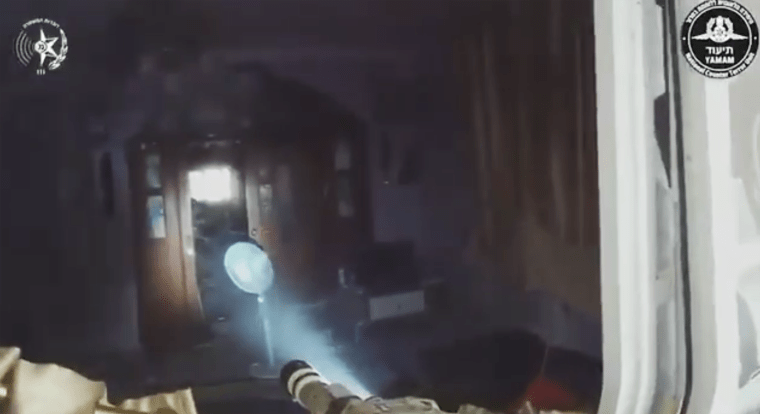
While there was jubilation in homes and streets across Israel, there was extreme pain in Gaza, where health officials said at least 274 people, including dozens of children, were killed during the raid. The IDF put the toll at fewer than 100 people on Saturday. It has not updated that number since then.
And the attack has forced two populations to reckon with the ongoing war, now in its ninth month, with a death toll that health officials in the enclave say has topped 37,000 and more than 100 hostages still being held in Gaza.
Daytime raid
The raid at the Nuseirat refugee camp began at 11 a.m. local time (4 a.m. ET) last Saturday morning, Rear Adm. Daniel Hagari, a spokesperson for the IDF, said in a video briefing shortly after the raid. Conducting the raid at that time gave troops an element of surprise, he said.
The Paratrooper Reconnaissance Unit Combat Team led the operation, the IDF said in a Telegram post on Sunday. It said that members of its Kfir Brigade Combat Team had been operating “for several days in the area,” alongside paratroopers and special forces from the Duvdevan Unit, which the IDF describes on its website as functioning “openly and undercover among the local Arab population.”
The IDF did not comment when asked by NBC News whether any troops involved in the operation were wearing civilian clothes or any other disguises, but the Israeli military has a long history of using these forces.
The Israel Police’s National Counter-Terrorism Unit, known as the Yamam, was also involved in the raid, and one of its members, Chief Inspector Arnon Zamora, was seriously wounded and later died of his injuries, an Israel Police spokesman said.
The IDF on Monday posted helmet camera footage of the raid that NBC News geolocated to a residential building on a side road from the main shopping street that bisects Nuseirat.
In the video, officers appear to ask the hostages for their names before Kozlov can be heard shouting back “Andrey” as both men raise their hands, appearing visibly shaken.
The video then appears to cut to their escape from the building. At this point, a time stamp appears, showing 10:15 a.m. Asked why the footage appeared to be taken 45 minutes before Hagari said the operation began, the Israel Police referred NBC News to the IDF, which declined to comment.
The apartment Argamani was held in was about 220 yards from the one where the three other hostages were held, Hagari said at the news conference, adding that the buildings were around three to four stories high. Both had families living in them and armed guards inside, he said. The IDF launched raids on both apartments simultaneously, Hagari said.
He did not explain how Israeli forces made their way into Nuseirat, and it is unclear why the IDF did not share video from the raid to free Argamani, who became a symbol of the hostage crisis after a video of her kidnapping from the Nova music festival was shared around the world.
Hagari said the IDF had come under intense fire after withdrawing from the apartments, but did not provide evidence for his claims.
Aerial assault ‘without warning’
Shopkeeper Abdulrahman Al-Taheawi told NBC News on Sunday that he saw a medium-sized truck enter the area along with other vehicles. He said troops removed two ladders from the truck and accessed the building before leaving with people he described as “prisoners” in tow.
A video shared widely on social media and geolocated by NBC News to the same location shows a white Mercedes-Benz 519 CDI van parked outside the building next to what looks like a ladder against the wall and a body lying on the ground. A video filmed later that day shows the building completely destroyed, part of the van visible in the rubble.
Calling the raid “heinous,” the United Nations said in a statement that the IDF “entered Nuseirat disguised as displaced persons and aid workers in a humanitarian truck.”
“These tactics put aid workers and the delivery of much needed humanitarian aid at even greater risk and expose an unprecedented level of savagery in Israeli military actions,” the statement said. The IDF did not comment to NBC News about this.
Al-Taheawi said the troops “left the place under heavy cover of fire,” then multiple houses were shelled. In what felt like a minute, he said, there were “more than 20” people killed in the street.
In a separate interview Sunday, Khalil Al-Kahlot said it was around 11:30 a.m. when suddenly “airplanes started to fire and people were lying in the street, without warning.”
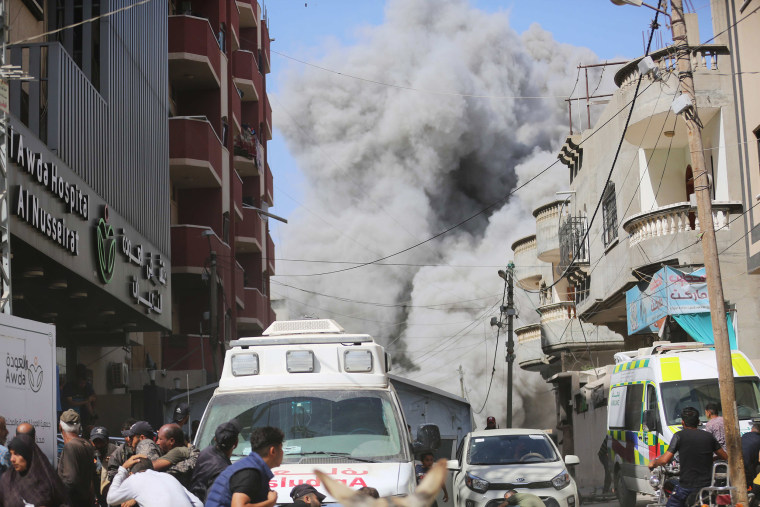
The IDF said in a Telegram statement Sunday that members of the Israeli Air Force’s specialist Shaldag Unit had directed “airstrikes and activation of fire throughout the operation,” along with members of the police’s Yamam unit. The IDF did not comment when asked by NBC News what had been targeted and why the targets had been chosen.
Gunfire and explosions could be heard across a square mile of the northeast of the camp in video verified by NBC News. Another showed two missiles approaching from different directions and slamming into a bus station where people had set up makeshift shelters. People can be seen running away from the area, although the footage does not show the aftermath of the strike.
Separate footage captured by NBC News’ crew on the ground shortly after Saturday’s raid showed bodies scattered across the streets of Nuseirat, one burned near a car.
Hellfire missiles
An analysis of missile fragments filmed by an NBC News crew as they were collected by residents showed they were pieces of AGM-114 Hellfire air-to-surface missiles, according to Richard Weir, an arms researcher at Human Rights Watch.
He said he had come to this conclusion based on the weight listed on the debris and orange balls called pneumatic accumulators that were found by the residents.
Former British Army Maj. Chris Cobb-Smith, a weapons and munitions expert, also said they were “almost certainly” Hellfire missiles.
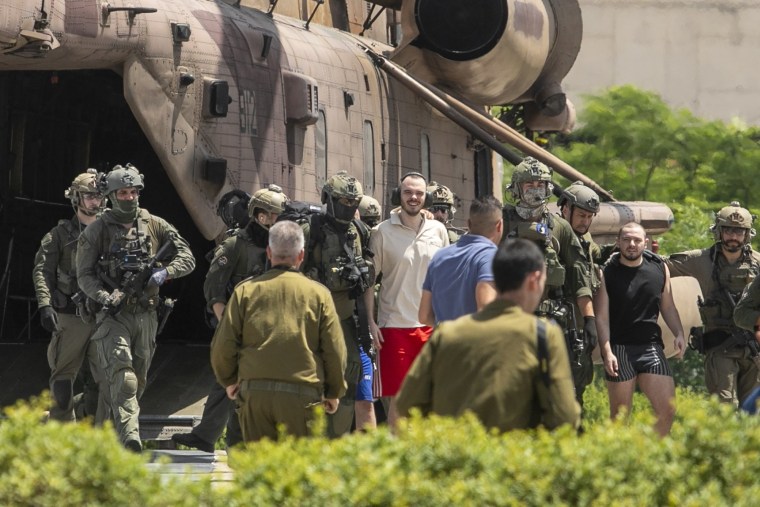
Hellfires are air-to-ground precision-guided missiles that can be fired from helicopters and other aircraft.
The U.S. did approve Israel’s purchase of 3,000 Hellfire missiles in 2015. But the State Department did not comment when asked by NBC News on Friday about the provision of missiles to Israel since then. “We do not have the ability to verify the use of particular munitions in conflicts to which the United States is not a party,” a spokesperson said. “We will let the IDF speak to what weapons were used in their operation,” they added.
Military contractor Lockheed Martin holds a registered trademark and patents for the missiles, and Weir said they were designed and developed in Orlando, Florida, and manufactured in facilities in several states including Texas and Alabama.
Lockheed Martin said in a statement that foreign military sales were “government-to-government transactions and we work closely with the U.S. government on any military sales to international customers.” It added that questions about Israel’s use of U.S. platforms were “best addressed by the U.S. or Israeli government.”
‘An absolute massacre’
Moureen Kaki, a Palestinian American from San Antonio, Texas, was working at the Al-Awda Hospital in Jabalia “when we heard sort of explosions and gunfire, just a variety of sounds that were clearly very close.”
It wasn’t long before “the casualties started pouring in,” Kaki, a logistics coordinator with Glia, a Canada-based health care organization, said Thursday. She added that she was disturbed to see “a lot of women and a lot of young people” among them.
Travis Melin, an anesthesiologist and critical care doctor from Portland, Oregon, was stationed at the Al-Aqsa Martyrs Hospital as part of the CADUS international disaster response team.
He said in an interview Thursday that he heard explosions ring out at around 10 or 11 a.m. local time, and the hospital was flooded with casualties not long after. Most striking was how many children were among them, he said. “To me, this was an absolute massacre of civilians, young people,” he said.
More than 37,000 people have been killed in Gaza, according to local health officials, since Israel launched its offensive in the enclave following Hamas’ Oct. 7 attacks, in which some 1,200 people were killed and around 250 others were taken hostage, according to Israeli officials.
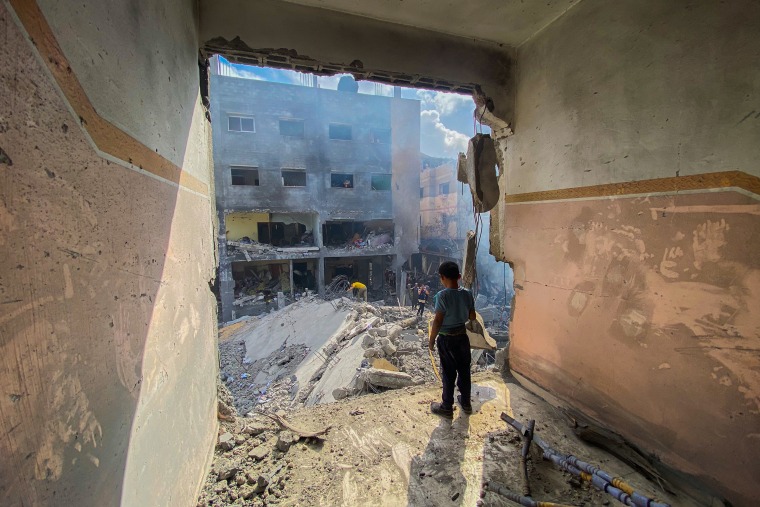
More than 100 people are thought to remain captive, including Argamani’s boyfriend, Avinatan Or. At least a quarter of them are believed to be dead, according to Israeli officials.
As the strikes rained down from the air, the IDF told NBC News that a vehicle carrying the three male hostages broke down while under fire, forcing commandos to hastily load the hostages into a separate vehicle before driving them to a waiting helicopter. The IDF declined to comment on whether the vehicle broke down or whether it was damaged in the firefight.
Asseel Jaber Jameel, 28, said the vehicle looked “ordinary,” one that could be used for transporting displaced people or carrying goods. When it stopped, he said, “its members started shooting like crazy.”
The IDF also published a video of a helicopter airlifting Argamani to safety. A second showed the three male hostages being flown out.
While they took off from a beach near an American-built pier constructed to help facilitate aid deliveries to Gaza, U.S. Central Command said it was “not used in the operation.”
However, a U.S. official with knowledge of the matter told NBC News that the United States provided intelligence in support of the rescue operation. American drones have been flying above Gaza for months and the U.S. shares intelligence gathered by them.
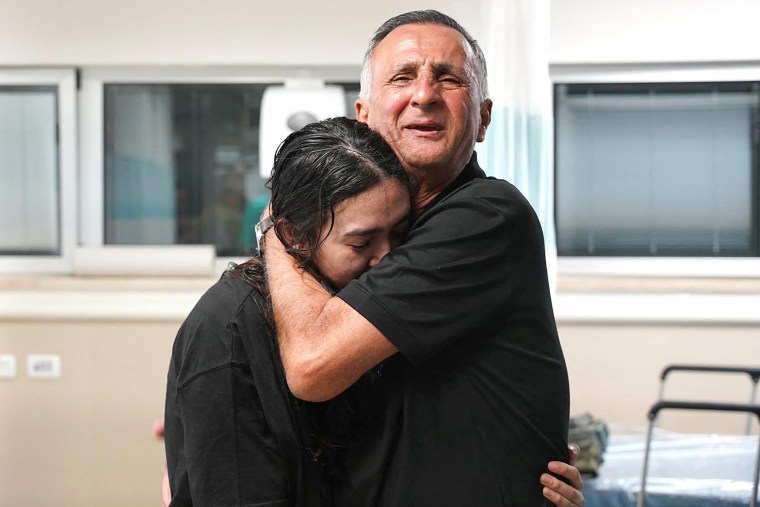
A spokesperson for the Sheba Medical Center near Tel Aviv said helicopters carrying the hostages started landing at the facility at around 12:30 p.m. (5:30 a.m. ET).
Within hours, the IDF published images and footage of emotional reunions between the hostages and their families. Kozlov was filmed falling to his knees at the sight of his mother, Evgeniia Kozlova, tears streaming down his face.
Argamani, who entered her 245th day in captivity when she was rescued, went to the Sourasky Medical Center in Tel Aviv to see her mother, Liora, who is being treated for terminal brain cancer.
In a phone call with Israel’s President Isaac Herzog, she said, “I’m so happy to be here.”
In Gaza, they were counting the cost.
“The crime is that all the world is watching our children dying and no one is doing anything,” Al-Kahlot said. “We have the right to live.”






